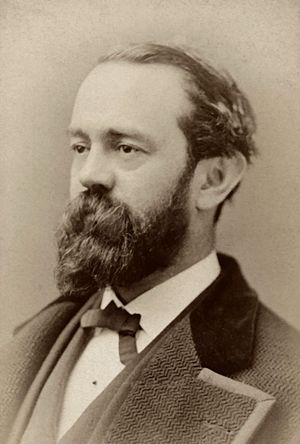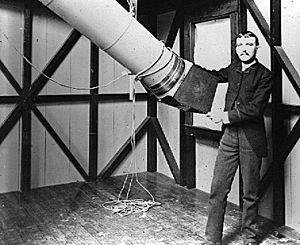Henry Draper facts for kids
Quick facts for kids
Henry Draper
|
|
|---|---|
 |
|
| Born | March 7, 1837 |
| Died | November 20, 1882 (aged 45) New York City, US
|
| Alma mater | New York University School of Medicine |
| Scientific career | |
| Fields | Astronomy |
| Signature | |
 |
|
Henry Draper (born March 7, 1837 – died November 20, 1882) was an American doctor and a passionate amateur astronomer. He is famous for being one of the first people to take amazing photos of stars and other objects in space. This is called astrophotography.
Life and Discoveries
Henry Draper came from a very smart family. His father, John William Draper, was a talented doctor, chemist, and professor at New York University. He was also the first person to take a photograph of the Moon using a telescope, back in 1840! Henry's mother was Antonia Caetana de Paiva Pereira Gardner. Her father was the personal doctor to the Emperor of Brazil. Henry's niece, Antonia Maury, also became an astronomer.
Henry graduated from New York University School of Medicine when he was 20 years old, in 1857. He first worked as a doctor at Bellevue Hospital. Later, he became both a professor and the dean of medicine at New York University. In 1862, he served as a surgeon in the army for a few months during the American Civil War.
In 1867, he married Mary Anna Palmer. She was a wealthy socialite who also helped him with his astronomy work.
Henry Draper was one of the first to use astrophotography. This means taking pictures of objects in space. In 1872, he took a photo of a star's spectrum. This showed lines that helped scientists understand what stars are made of. Other scientists like Joseph Fraunhofer and Angelo Secchi had also worked on this.
In 1873, he left his job at the medical school. This allowed him to spend more time on his important research in astronomy.
Photographing Space Objects
Henry Draper led a team to photograph the 1874 transit of Venus. This is when Venus passes directly in front of the Sun. He was also the first person to photograph the Orion Nebula. He took this famous picture on September 30, 1880. He used a special telescope and took a 50-minute exposure. This means the camera lens was open for 50 minutes to collect enough light. In 1880, he also photographed the spectrum of the planet Jupiter.
Draper's observatory was in Hastings-on-Hudson, New York. This is where he took many of his amazing photos of the Moon. Today, that building is used by the Hastings-on-Hudson Historical Society.
Awards and Legacy
Henry Draper received many awards for his work. He got honorary law degrees from New York University and the University of Wisconsin–Madison in 1882. He also received a special medal from the U.S. Congress. This was for leading the expedition to photograph the 1874 transit of Venus. He was chosen to be a member of important groups like the United States National Academy of Sciences.
Sadly, Henry Draper died young from a lung illness in 1882. After his death, his wife, Mary Anna Draper, continued his legacy. She created the Henry Draper Medal. This award is given to scientists who make great contributions to astrophysics. She also funded a telescope. This telescope was used to create the Henry Draper Catalog. This catalog lists and describes the spectra of many stars.
Today, the historical Henry Draper telescope is in Poland. A small crater on the Moon is also named Draper in his honor.
See also
 In Spanish: Henry Draper para niños
In Spanish: Henry Draper para niños
- Andrew Ainslie Common
- Henry Draper Medal
- Henry Draper Catalogue


